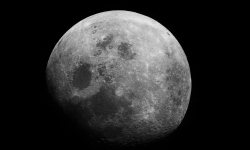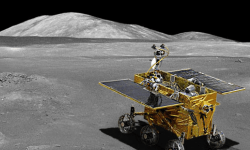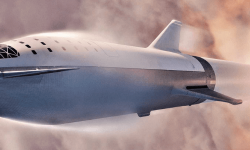
China and France collaborate more and more on common projects
– News of April 2, 2019 –
China seeks to collaborate with other countries in its space program, including France. The visit to France of Xi Jinping, the President of the Popular Republic of China, was the opportunity to sign a new agreement on space exploration. The two countries are already collaborating quite closely. Last year, CNES and CNSA jointly launched an oceanography satellite. ESA also provides its network of antennas to help monitor the Chinese lunar missions Chang’e. The lunar exploration program is precisely at the center of the new collaboration between France and China.
The Chang’e 6 mission should embark French scientific instruments. Chang’e 6 is a sample collecting and return mission that is expected to take place in 2023 or 2024. The mission is based exactly on the Chang’e 5 mission architecture, which should be launched this year. We don’t know yet whether this collaboration will allow French scientists to participate in the analysis of the samples collected.
The other part of this agreement is about Earth observation. China is already participating in the Space Climate Observatory program, which aims to pool satellite data from several countries. The goal of this initiative is to facilitate the work of monitoring climate change. France and China will also design a new joint observation mission. It will be dedicated to ocean salinity and soil moisture. It will be interesting to see how much France and Europe will support the American and Chinese lunar programs. If they compete explicitly, there may be pressure on Europe to choose sides.

China could become space sector leader in two years
– News of October 30, 2018 –
The Chinese space sector is very dynamic, whether it is the public sector or the private sector. Yesterday, a Long March 2C put into orbit an oceanography satellite jointly developed by CNES and CNSA. This satellite should provide a better understanding of how waves and wind function, which is important for modeling the interactions between the oceans and the atmosphere. It was the 31st orbital launch of the year for China. The record of 22 launches in 2016 has already been largely beaten. But China wants to go further. By the end of 2018, China is expected to do 35 to 40 launches, which could make China the first nation in terms of orbital launches.
But everything is not perfect. The LandSpace company failed in its first orbital launch attempt. It seems that the third floor of the launcher did not work as planned. This first launcher called Zhuque-1 targets the Smallsats market with relatively low orbit capacity. This does not prevent LandSpace from having much more ambitious plans in parallel. The company then wants to develop a medium-capacity methane-powered launcher. More than 10 other Chinese companies are advancing more or less quickly on similar projects.
OneSpace is expected to complete the next orbital launch trial before the end of the year. Yesterday, we saw a test prototype of a launcher capable of landing vertically, which is quite similar to SpaceX’s Grasshopper launcher. A reusable Chinese launcher could arrive faster than we believe. In parallel, the Chinese government continues to conduct an extremely ambitious program, especially on the side of manned flight. In recent days, we have seen on social networks some photos of the Tianhe module that will be the core of the next Chinese space station. This module has a length of almost 17 meters and a maximum diameter of more than 4 meters. It is expected to be launched in 2020 aboard a Long March 5B rocket.
China wants to take advantage of this new space station to boost its international collaborations. A Shenzhou spacecraft is expected to embark a Pakistani astronaut by 2022, and more than 30 international teams have already applied to send their payloads aboard the new Chinese space station. China continues to focus on the lunar objective. In a presentation that took place a week ago, we could distinguish on a photo a space station in lunar orbit and a descent module with rather original architecture.
For the planet Mars goal, China seems to be holding the deadlines for its Martian rover, which is scheduled to be launched in 2020. The parachutes and the system of retrorockets that must allow a landing on the red planet have been successfully tested. The landing on Mars is a much bigger challenge than on the Moon, which is why half of the Martian missions have been failures. In two years, we will see if the Chinese are able to fulfill their objectives. The mission will embark 13 scientific instruments distributed between the orbiter and the rover of the mission.
Over the next two years, the Chinese space agency will launch manned flights, a new space station, several lunar missions and a mission to the planet Mars. If the promises of the private sector are also kept, China can become a leader in the space sector.
Chinese space program sails between dynamism and contrarieties
– News of October 2, 2018 –
China is becoming a major space nation. In 2018, China has already made 26 orbital launches without any failures. This is two more launches than the United States of America, despite frequent SpaceX rocket launches. It is forbidden for NASA and all the companies of the American space sector to collaborate with China. Only the US Congress can stop this ban. China is developing several space programs alongside the Long March 9 space rocket. For example, recent days have seen the development of the Long March 6-X, a new reusable launcher.
The private sector is also very active. The last of the 26 orbital launches of China was made by the company ExPace with its rocket Kuaizhou 1A, a light launcher dedicated to Smallsats. But ExPace hopes to make the first launch of a heavier launcher called Kuaizhou 11 (KZ-11) before the end of the year. The company plans seven additional launches by the end of 2019.
Many other Chinese start-ups are expected to launch their first orbital launch in the coming months and years. At the end of October, LandSpadce could become the first Chinese company to reach orbit with entirely private fundings. Their launcher called Zhuque-1, also called LandSpace-1, will put into orbit a small Earth observation satellite. In 2020, LandSpace hopes to bring to market a more powerful launcher that burns methane and potentially reusable, called Zhuque-2 (ZQ-2). Last Thursday, they did a test of the engine that will equip this new launcher.
OneSpace, another Chinese private company, made its second suborbital launch in September. OneSpace is developing a series of launchers for Smallsats, the first of which could be tested in the fourth quarter.
If all goes as planned, three Chinese private companies will have orbital capabilities before the end of the year. The contrast is striking when compared to what is happening in the West, where Rocket Lab is having trouble making its second launch and other private space companies appear to be late. But not everything is ideal in the Chinese space program. The launches of the Long March 5, a crucial rocket for the government space program, will be postponed until 2019. This means that the new Tiangong 3 space station and the Chang’e 5 lunar return mission will also be delayed. .
In addition, a scandal broke out in China over wage differences between the public and private sectors. New space companies would pay their researchers and engineers almost ten times more than public agencies, which could lead to a shortage of talent among government contractors and a general slowdown in Long March space rocket programs.
CNSA increases rocket launches
– News of July 10, 2018 –
China will set new records for rocket launches. In January, the China National Space Administration (CNSA) announced plans to carry out some 40 rocket launches in 2018. For the moment, the pace is being maintained. This high rythm allows China to be present everywhere : Earth observation, satellite navigation system, exploration of the Moon and Mars, manned flights, space station… Moreover, the efforts of the CNSA are supported by a burgeoning private industry : the start-up One Space realized last May the first suborbital shot of one of its rockets, while another Chinese company has just been funded $ 90 million to develop its launcher. Among the multitude of projects that are emerging in China, two projects of the China National Space Administration are strategic : the super heavy launcher Long March 9 (Chang Zheng-9) and the reusable rocket Long March 8 (Chang Zheng-8).
At a conference, a designer revealed that Long March 9 will have a first floor 10 meters in diameter, which is wider than SpaceX’s BFR or NASA’s SLS. This width is comparable with the width of the Saturn 5. In addition, the rocket will be equipped with four boosters with a diameter of 5 meters each. The Long March 9 will have a floor width of 20 meters, for a height of 93 meters. The set will form a total mass of 4000 tons at takeoff and will be powered by engines developing 6000 tons of thrust. This will allow the launcher to place 140 tons of payload in low orbit, 50 tons in transfer orbit to the moon or 44 tons in transfer orbit to Mars. The rocket will be used for a mission to return Martian samples and for manned flights to the Moon. The CNSA is aware of the scope of the project and gives itself until 2030 to make a first flight.
Long March 8 should arrive much faster. This launcher is CNSA’s first attempt to develop a reusable rocket like SpaceX can. Long March 8 is a medium-capacity launcher that will use two powder boosters. The first floor and the two boosters will probably be recovered by landing vertically. Boosters will stay glued to the first floor. Long March 8 could be launched as early as 2021 and will be offered on the international commercial market. Prices proposed by the China National Space Administration should be very low, which would increase even more the launch pace.
China will launch more rockets than Russia as early as 2018
– News of January 16, 2018 –
China is a rising power in all areas. This is also true in the space field. China has an ambitious space program, the scientific part of which bets on the manned space stations, and on lunar exploration. In 2017, China launched 18 orbital rockets, placing it third in the world behind the United States and Russia. But in 2018, China hopes to launch 40 rockets, it will put it ahead of Moscow and perhaps even in front of the United States if SpaceX does not respect the announced pace. In 2018, the Chinese should again use the heavy launcher Long March 5, which had failed during its second flight last summer. Yet it is a very important rocket for China because it is the one which must put in orbit the different modules of the new Chinese space station. It is also the one which must launch the Lunar exploration missions Chang’e.
All these launches are not made by the Chinese government. Like the rest of the planet, China is letting more and more private companies launch their rockets. One of them, LandSpace Technology, is expected to launch its LandSpace-1 rocket for the first time this year. LS-1 should be marketed worldwide. A first launch contract with a Danish company has been signed. LandSpace-1 will have a one-ton capacity in low Earth orbit. But LandSpace is already working on a more powerful rocket capable of competing with Ariane 5 and the Falcon 9. Another important advance for the Chinese, ten satellites of the Beidou constellation should be launched this year. Beidou is the Chinese equivalent of American GPS. By way of comparison, Europe will only launch four satellites of the Galileo constellation during the same period.
The face of the space industry is changing profoundly. For decades, Russians and Americans shared the majority of launches, while Ariane allowed Europe to shine on the commercial front. The proliferation of countries and companies involved in the space sector should lead to a much more competitive and fragmented market in the coming years. Competition often generates innovations.
China and France collaborate to create a satellite
– News of November 7, 2017 –
China is opening up to international collaborations. This is still the case with the presentation of the CFOSAT satellite, a Franco-Chinese satellite resulting from the collaboration between CNES and its Chinese counterpart. It is a satellite of climate study that will observe the interactions between the oceans and the Earth’s atmosphere. The two study centers will each design one of the instruments that will equip the satellite, which will be launched next year on a Long March 2 rocket. The satellite is scheduled for a three-year mission.
Beyond the scientific interest of the program, CFOSAT perfectly illustrates the rapprochement of China with international organizations, and with France in particular. In fact, although the satellite was only presented last month, the project started ten years ago. And it’s not the only one of its kind. In April, the European and Chinese space agencies confirmed to discuss the possibility of a common lunar base. ESA hopes to be able to carry out analyzes on the lunar samples that will be brought back by the Chang’e 5 probe, which was postponed until 2019. Finally, the Europeans would be in favor of sending one or two astronauts to the future Chinese space station. But the real question is whether Sino-US collaboration is possible.
Both powers have their eyes on the moon, with manned flight programs under development. But it is currently impossible for China and NASA to collaborate. In 2011, the US Congress passed a decree that formally forbids any collaboration between NASA and China. One can be optimistic and say that nothing prevents a decree from being revoked. For example, the United States of America now cooperates with Russia in the space sector after decades of rivalry. As often, the solution can only come from strong political will.
It will also be interesting to see how Europe will position itself against the ambitious programs of other space agencies. Can it both work on the LOP-G with the United States of America and on a lunar basic project with China, without the two programs being linked ? It sounds absurd and maybe Europe will have to make a choice.









